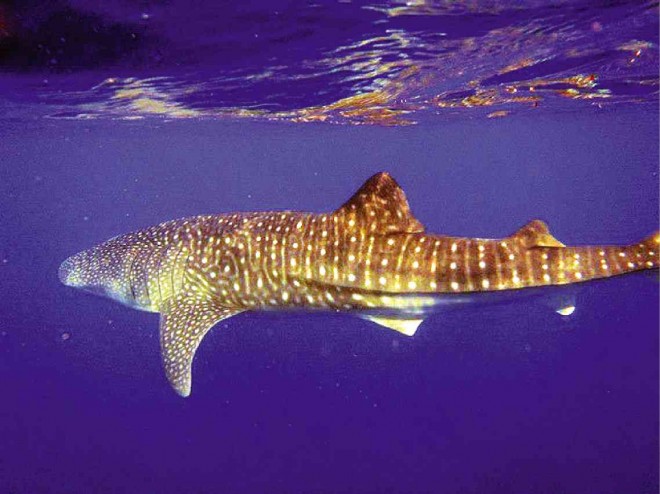‘Let whale sharks remain wild’ at sea

A WHALE SHARK in the southwest reef of Danjugan Island, Negros Occidental province Terence Dacles/ Contributor
Whale sharks or the “butanding” made their presence felt in southern Negros Occidental province in mid-November, drawing local and foreign tourists.
Conservationists, however, are appealing to them not to treat the whale sharks—considered the world’s largest fish—as “circus animals” in the wake of experiences in Donsol town in Sorsogon province, Oslob town in Cebu province and in other areas.
Tourists have been coming to Hinobaan town in Negros Occidental to catch a glimpse of the butanding feeding on small shrimps, the town mayor, Ernesto Estrao, said.
On November 15, seven of the fish were seen in Nabulao Bay.
Two were big—one weighing 4,000 kilograms. By the end of the month, they were swimming toward Danjugan, a 43-hectare island owned by the conservation group Philippine Reef and Rainforest Conservation Foundation Inc. (PRRCFI).
Article continues after this advertisementIsland sanctuary
Article continues after this advertisementDanjugan, 1.5 kilometers long and half a kilometer at its widest point, has five lagoons. Its lush cover of limestone forests provides sanctuary to many wildlife species struggling to survive in the mainland 3 km away.
Together with Sipalay City and Hinobaan, the island forms the southern border of the province. It is situated in Sulu Sea, an important ecological region for marine biodiversity, according to Gerry Ledesma, PRRCFI president.
The surrounding reef is under the Danjugan Island Marine Reserve and Sanctuaries, which has made the area a rich feeding ground for whale sharks and dolphins.
Marine biologist Mark de la Paz said many sightings of the marine animals had already been reported in Negros Occidental and other areas in Western Visayas, particularly through social networking sites.
Described as “gentle giants” for their size but generally harmless behavior, the whale sharks can reach lengths of up to 12 meters (40 feet) or longer, according to National Geographic. Those stranded in Panay weighed from 1,000 kg to 3,000 kg and were 5 m to 7 m long, said Mateo Doyola Jr., an aquaculturist at the Bureau of Fisheries and Aquatic Resources (BFAR) and the team leader of the agency’s regional quick-reaction team.
Threatened
The whale sharks, distinguishable by the unique combination of dark and light spots and stripes on their skin, are among the threatened animals included in the International Union for Conservation of Nature Red List.
Under the Department of Agriculture’s Fisheries Administrative Order No. 193, catching whale sharks to “sell, purchase, possess, transport or export, whether raw or processed,” is prohibited. It is also illegal to wound or kill whale sharks.
Violators face a fine of P500 to P5,000 or imprisonment from six months to four years or both.
Stranded whale sharks are released back to the sea unless they need treatment for wounds or need to physically recover, Doyola said.
The presence of whale sharks in Western Visayas is part of their normal migratory behavior to search for food, said May Guanco, assistant regional director of the BFAR.
Concentration of small shrimps peaks usually from November to March, mostly along the western side of Panay, Guimaras and Negros islands.
Feeding behavior
In the past several years, whale sharks had been spotted or stranded off Barbaza town in Antique province, Iloilo City, Jordan and Nueva Valencia towns in Guimaras province, Numancia town in Aklan province and Roxas City in Capiz province.
Once the supply of food is depleted, the giant fish move to other areas, Doyola said.
Since southern Negros faces the open Sulu Sea, it is a “natural” passageway, De la Paz said.
Both the BFAR and PRRCFI have appealed to coastal villagers and tourists to leave the whale sharks alone in their natural environment and behavior patterns. “Let them remain wild,” De la Paz also urged.
They should be undisturbed when they seek food and their natural behavioral patterns should not be tampered with, Ledesma said. He cited the case of Oslob, where the animals are being fed so tourists can see them.
Guanco said tourists should be advised to keep distance from the whale sharks, especially from the animals’ mouth and tail. Still, the best thing for them is to leave the fish alone in their natural habitat.
“What is important is that they are protected, not exploited,” De la Paz said.